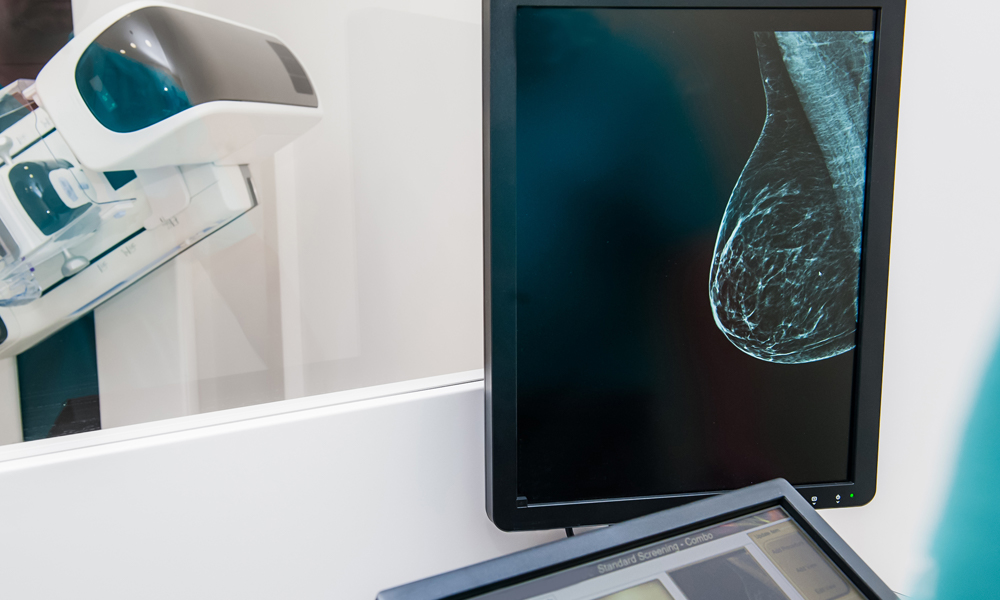California legislature recently passed a law requiring that women who have screening mammograms are informed by their health care provider if they have dense breast tissue. This makes California the 5th state in the nation to require this notification. Effective April 1, 2013, California women who have dense breasts must receive the following statement in writing as part of their mammogram result letter:
Your mammogram shows that your breast tissue is dense. Dense breast tissue is common and is not abnormal. However, dense breast tissue can make it harder to evaluate the results of your mammogram and may also be associated with an increased risk of breast cancer. This information about the results of your mammogram is given to you to raise your awareness and to inform your conversations with your doctor. Together, you can decide which screening options are right for you. A report of your results was sent to your physician.
 We’ve been working hard on this. Add your e-mail address and we will tell you as soon as it launches.
We’ve been working hard on this. Add your e-mail address and we will tell you as soon as it launches.
What did your report say before the law?
Radiologists have routinely reported breast density as part of their interpretation for years – this is usually provided in the report sent to the your physician. However, up until now, it has not been a part of the standard results letter that women receive when their mammogram is negative. By including breast density in a patient’s mammogram report going forward, each woman is alerted that while her mammogram is negative, the dense breast tissue could make it more difficult to detect cancer, which should be taken into consideration and discussed with a physician.
Get discounted Tier 2 tickets while they last. Watch the Summit via on-demand video from anywhere or attend in person at the breathtaking oceanfront Terranea Resort in Southern California.
Some Facts about Dense Breasts
Explained in more detail in our Breast Density post, dense breast tissue can decrease the chances and accuracy of detecting cancer on a mammogram. Dense breast tissue appears white on a mammogram – the same color as cancer. This creates an overlap effect and often allows the cancer to “hide” amongst the white breast tissue, making it difficult to detect by the radiologist. According to the American Cancer Society, breast density ranks among the top risk factors for breast cancer, with its place just below the risk for BRCA 1 or 2 gene mutation carriers, strong family history, and personal history of breast cancer.
Follow Power Up
Follow Power Up
The California Breast Density Law
BILL NUMBER: SB 1538
INTRODUCED BY Senator Simitian
(Principal coauthors: Senators Alquist and Runner)
(Principal coauthor: Assembly Member Nielsen)
(Coauthors: Senators Anderson, Berryhill, Blakeslee, Calderon, Cannella, Corbett, Correa, De León, DeSaulnier, Dutton, Emmerson, Evans, Fuller, Gaines, Hancock, Harman, Huff, La Malfa, Leno, Lieu, Liu, Lowenthal, Negrete McLeod, Padilla, Pavley, Price, Rubio, Steinberg, Strickland, Vargas, Walters, Wolk, Wright, Wyland, and Yee)
(Coauthors: Assembly Members Achadjian, Alejo, Allen, Beall, Bill, Berryhill, Block, Bonilla, Brownley, Buchanan, Butler, Charles, Calderon, Campos, Carter, Cedillo, Chesbro, Conway, Davis, Dickinson, Eng, Feuer, Fletcher, Fong, Furutani, Galgiani, Garrick, Gatto, Grove, Hagman, Hall, Harkey, Hayashi, Roger Hernández, Hill, Huber, Hueso, Huffman, Jeffries, Jones, Knight, Lara, Logue, Bonnie Lowenthal, Ma, Mansoor, Mendoza, Miller, Mitchell, Morrell, Nestande, Olsen, Perea, V. Manuel Pérez, Portantino, Skinner, Smyth, Solorio, Swanson, Torres, Valadao, Wagner, Wieckowski, Williams, and Yamada)
FEBRUARY 24, 2012
An act to add and repeal Section 123222.3 of the Health and Safety Code, relating to mammograms.
LEGISLATIVE COUNSEL’S DIGEST
SB 1538, Simitian. Health care: mammograms.
Existing law requires specified information to be provided to patients regarding their health care. Existing federal law requires a written report of the results of each mammography examination and requires a summary of that report to be sent to the patient within a specified time period.
This bill, from April 1, 2013, until January 1, 2019, would require, under specified circumstances, a health facility at which a mammography examination is performed to include in the summary of the written report that is sent to the patient a prescribed notice on breast density.
THE PEOPLE OF THE STATE OF CALIFORNIA DO ENACT AS FOLLOWS:
SECTION 1. Section 123222.3 is added to the Health and Safety Code, to read:
123222.3.
(a) A health facility at which a mammography examination is performed shall, if a patient is categorized by the facility as having heterogeneously dense breasts or extremely dense breasts, based on the Breast Imaging Reporting and Data System established by the American College of Radiology, include in the summary of the written report that is sent to the patient, as required by federal law, the following notice: Your mammogram shows that your breast tissue is dense. Dense breast tissue is common and is not abnormal. However, dense breast tissue can make it harder to evaluate the results of your mammogram and may also be associated with an increased risk of breast cancer. This information about the results of your mammogram is given to you to raise your awareness and to inform your conversations with your doctor. Together, you can decide which screening options are right for you. A report of your results was sent to your physician.
(b) This section shall become operative on April 1, 2013.
(c) (1) Nothing in this section shall be construed to create or impose liability on a health care facility for failing to comply with the requirements of this section prior to April 1, 2013. (2) Nothing in this section shall be deemed to create a duty of care or other legal obligation beyond the duty to provide notice as set forth in this section. (3) Nothing in this section shall be deemed to require a notice that is inconsistent with the provisions of the federal Mammography Quality Standards Act (42 U.S.C. Sec. 263b) or any regulations promulgated pursuant to that act.
(d) This section shall remain in effect only until January 1, 2019, and as of that date is repealed, unless a later enacted statute, that is enacted before January 1, 2019, deletes or extends that date.

















